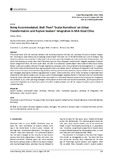Citation link:
http://dx.doi.org/10.25819/ubsi/9835| DC Field | Value | Language |
|---|---|---|
| crisitem.author.orcid | 0000-0002-5660-3834 | - |
| dc.contributor.author | Meier, Sabine | - |
| dc.date.accessioned | 2021-07-06T13:49:33Z | - |
| dc.date.available | 2021-07-06T13:49:33Z | - |
| dc.date.issued | 2018 | de |
| dc.description | Finanziert aus dem DFG-geförderten Open-Access-Publikationsfonds der Universität Siegen für Zeitschriftenartikel | de |
| dc.description.abstract | This article deals with the interplay between the rescaling processes of cities and pathways of asylum seekers’ integration. Building on scale theory and employing a downscaled mid-sized city in the Netherlands as a unit of analysis, two research questions are answered. Firstly, what kind of urban planning strategies do urban authorities of downscaled, midsized cities develop to rescale their cities? Secondly, how are these strategies related to the imagined pathways of asylum seeker integration? Here, the term ‘scale’ does not refer to an absolute ‘spatial object’ that is able to affect social reality. Rather, scales are socially produced through negotiation processes which are contested and heterogeneous. It is argued that Dutch urban authorities and housing corporations take a normative view of ‘pathways of integration’ and standardise these in terms of space, time and financing. By these socially produced scale processes, asylum seekers’ accommodation is well-managed, keeping the residents regulated and ‘in place’. Urban authorities utilise ‘scalar narratives’ to legitimate their interactions with asylum seekers and the way in which disadvantaged neighbourhoods in mid-sized cities are transformed. Using the Dutch mid-sized city Kerkrade as the case study, it is illustrated that local opportunity structures for integration are confined by (1) urban planning strategies mainly based on residential and tourism economies, (2) the perception of successful integration via a small-scale social mix within neighbourhoods, and (3) the neglect of public representation of cultural diversity. | en |
| dc.identifier.doi | http://dx.doi.org/10.25819/ubsi/9835 | - |
| dc.identifier.uri | https://dspace.ub.uni-siegen.de/handle/ubsi/1866 | - |
| dc.identifier.urn | urn:nbn:de:hbz:467-18663 | - |
| dc.language.iso | en | de |
| dc.source | Urban Planning ; Volume 3, Issue 4, S. 129–140. - DOI: https://doi.org/10.17645/up.v3i4.1670 | de |
| dc.subject.ddc | 710 Landschaftsgestaltung, Raumplanung | de |
| dc.subject.other | Asylum seekers | en |
| dc.subject.other | Downscaled cities | en |
| dc.subject.other | Netherlands | en |
| dc.subject.other | Mid-sized cities | en |
| dc.subject.other | Multiscalar approach | en |
| dc.subject.other | Urban transformation | en |
| dc.subject.other | Kerkrade | en |
| dc.subject.swb | Kerkrade | de |
| dc.subject.swb | Niederlande | de |
| dc.subject.swb | Integration | de |
| dc.subject.swb | Asylbewerber | de |
| dc.subject.swb | Stadtentwicklung | de |
| dc.title | Being accommodated, well then? ‘Scalar narratives’ on urban transformation and asylum seekers’ integration in mid-sized cities | en |
| dc.title.alternative | Gut untergebracht, und dann? „Skalare Erzählungen“ zu urbaner Transformation und Integration von Asylbewerbern in mittelgroßen Städten | de |
| dc.type | Article | de |
| item.fulltext | With Fulltext | - |
| ubsi.publication.affiliation | Fakultät II (Bildung, Architektur, Künste) | de |
| ubsi.source.doi | 10.17645/up.v3i4.1670 | - |
| ubsi.source.issn | 2183-7635 | - |
| ubsi.source.issued | 2018 | de |
| ubsi.source.issuenumber | 4 | de |
| ubsi.source.link | https://www.cogitatiopress.com | de |
| ubsi.source.pagefrom | 129 | de |
| ubsi.source.pageto | 140 | de |
| ubsi.source.place | Lissabon | de |
| ubsi.source.publisher | Cogitatio Press | de |
| ubsi.source.title | Urban Planning | de |
| ubsi.source.volume | 3 | de |
| ubsi.subject.ghbs | WZT | de |
| ubsi.subject.ghbs | WUBK | de |
| Appears in Collections: | Geförderte Open-Access-Publikationen | |
Files in This Item:
| File | Description | Size | Format | |
|---|---|---|---|---|
| Meier_Being_accommodated.pdf | 1.03 MB | Adobe PDF |  View/Open |
This item is protected by original copyright |
Page view(s)
333
checked on Nov 30, 2024
Download(s)
89
checked on Nov 30, 2024
Google ScholarTM
Check
Altmetric
Items in DSpace are protected by copyright, with all rights reserved, unless otherwise indicated.

